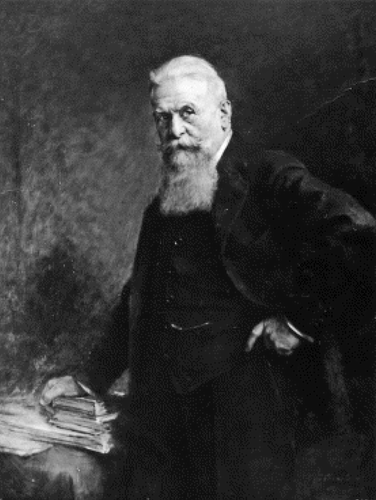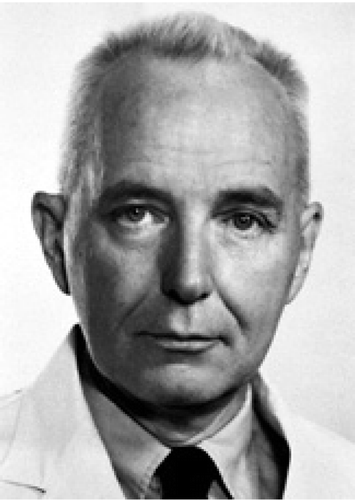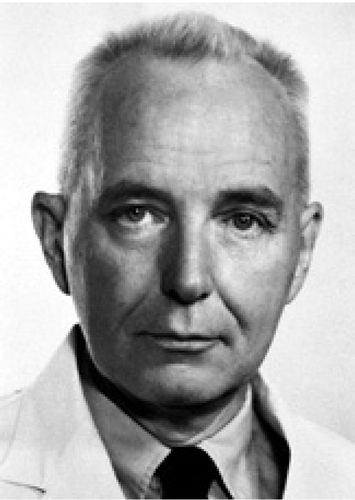Vasectomy and rejuvenation
The Spur
You think it horrible that lust and rage
Should dance attention upon my old age;
They were not such a plague when I was young;
What else have I to spur me into song?
W.B. Yeats (1865–1939)
The treatment, pioneered by the Viennese physiologist Eugene Steinach (), was commonly performed in the 1920s and 30s in ageing men with symptoms thought to be a consequence of declining testosterone (T) levels. Such patients, including Sigmund Freud, could expect as a consequence re-growth of hair, better colour, better erections, less premature ejaculation and heightened libido Citation[2]. The popularity of the procedure declined in the 1940s as T analogues became available.
Testosterone and prostate cancer
It was around this time that a most far reaching study, also concerning T, was being completed by Charles Huggins () and his medical student Clarence Hodges Citation[3]. As part of their investigations on the effects of hormones on metastatic prostate cancer, they treated eight men with castration. They then gave stilboesterol to five and T to three, using a fall in serum acid and alkaline phosphatase as a surrogate marker for regression of bone metastases. A reduction in acid phosphotase was demonstrated with orchidectomy and stilboesterol, and the reverse with T. This final finding appears, more than any other, to have propagated the now seemingly incorrect belief that increased T levels correspond with a heightened propensity for the development of prostate cancer.
Over the next decade there was ‘a revolutionary transformation in the treatment of prostate cancer through endocrine control, an advance based largely on the work of Charles Huggins’Citation[4].
Testosterone and vasectomy and prostate cancer
As vasectomy became a globally available contraception option, the idea that the procedure might induce improved libido or sexual performance was actively discouraged by those concerned that this might influence patient choice Citation[5]. However, the hypothesis that vasectomy would increase T levels was formally tested following reports in the early 1990s suggesting a causative link between vasectomy and the development of prostate cancer. Perhaps the most significant of these concerned almost 15,000 American nurses who had previously declared vasectomy as their method of contraception Citation[6]. Ten years on they were questioned, as were a cohort whose partners hadn't had vasectomy, as to whether the men had developed prostate cancer. This particular study revealed a greater than 50% increased risk, while other reports suggested an even more dramatic difference Citation[7]. Increased T levels were suspected but there was little hard evidence to support this. A Chinese study compared 91 men who had undergone vasectomy with 91 who hadn't and found a statistically significant difference in only dihydrotestosterone (DHT) levels Citation[8].
Only at the beginning of this century has there been sufficient data available to perform meaningful meta-analyses to refute the suggestion that men who have undergone vasectomy are more likely to develop prostate cancer Citation[9]. The presumption that, because the cancer responds to hormone deprivation, high levels of T will increase the risk of developing it in the first place has persisted until very recently Citation[10], despite strong evidence disproving a cause Citation[11].
Hypogonadism and prostate cancer
In the last few years attention has focused not on raised, but reduced levels of T. These are now thought to be linked to the development of a myriad of conditions, including heart disease, diabetes, erectile dysfunction and premature death, although it is yet to be clarified whether replacing T in isolation is sufficient to improve health or whether reduced levels are indicative of pronounced systemic degeneration Citation[12].
Perhaps the most striking connection, given the previously seemingly unshakeable interpretation of Huggins' work, is a link between hypogonadism and high grade, poor prognosis prostate cancer Citation[13]. There are an increasing number of studies supporting this hypothesis. For example, in 279 men undergoing radical prostatectomy; 69% with low T levels for their age had Gleason grade 7 or greater compared with 39% with normal levels. There was also a statistically significant difference in estimated 5 year disease free survival Citation[14].
Oestrogens and testosterone and prostate cancer
T supplements alone are, however, unlikely to be effective in preventing the development of high grade cancer. It is interesting to reflect that when it was believed that raised T as a risk factor, we not only were unable to explain the paradox that levels decline with age as the disease becomes more prevalent, but failed to highlight that the ratio of plasma androgen to oestrogen also falls Citation[15].
Another remarkable aetiological phenomenon regarding prostate cancer is the geographical variance. The disease is more clinically prevalent in the West, and intriguingly, not only does the risk of cancer in immigrants approach that of western natives after a generation Citation[16], but also there has been a significant rise in Eastern countries where a dairy and meat-based diet is increasingly consumed Citation[17]. Authors have highlighted the similarities in the aetiology and epidemiology of breast and prostate cancers, and one has described these as ‘acquired nutritional disease that can be prevented by lifestyle and dietary changes’Citation[18]. Sex hormones play a significant role in the development and progression of both, although it must be remembered that T is no more the ‘male hormone’ than oestrogen the ‘female’ one. We know that the obese have a greater risk of high grade prostate cancer and that aromatisation to oestrogens occurs in such patients Citation[19]. Could it be, then, that it is sex hormones, and specifically oestrogens, which act as the intermediaries between exogenous factors and the molecular targets, predisposing to development of the disease?
There is increasing evidence that oestrogen concentrations are critical in their autocrine and paracrine effects on the prostate, and that alteration in the hormonal milieu between these and T are associated with the neoplastic process Citation[20].
Testosterone is converted to DHT by 5-alpha reductase (5αR) and to oestradiol by aromatase. Disturbances in the balance of these enzymes and hormones, and altered expression of their receptors, have been studied in prostate cancer. Following Huggins' work androgen deprivation has been the mainstay of treatment for advanced cancer, and more recently androgen receptor blockade is used alone or to augment such therapy, while 5αR inhibition has been tested as a means of disease prevention Citation[21].
When aromatase knock out mice (unable to convert T to oestradiol) are given androgens, benign prostatic hyperplasia but not malignancy develops Citation[22]. Similarly, oestrogen receptors play a crucial role in regulation of prostate proliferation in animal models and altered expression is seen in vivo Citation[23],Citation[24]. This raises the possibility of using aromatase inhibitors and selective oestrogen receptor modulators (SERMs) for prostate cancer prevention and treatment Citation[20],Citation[25],Citation[26].
Conclusion
It would seem that Yeats really did benefit from his procedure and that the lust and rage that resulted, even in the absence of altered physiology, improved his latter years. There is now, though, compelling evidence that reduced T levels are associated with poor health in the aging male.
It is of concern that for sixty years the incorrectly interpreted results of a study on three patients so influenced our beliefs as to the endocrine basis of prostate cancer development. We must look not just at the ‘male hormone’ but at the many competing influences, as we learn more about this enigmatic condition.
References
- Foster R F. WB Yeats: A life. Volume 2: II The arch poet 1915–1939. OUP, Oxford 2003
- Benjamin H. The effects of vasectomy (Steinach's operation). Am Med 1922; 28: 435–443
- Huggins C, Hodges C V. Studies on prostatic cancer: 1. The effect of castration, of estrogen and of androgen injection on serum phosphotases in metastatic carcinoma of the prostate. Cancer Res 1941; 1: 293–297
- Nesbit R M, Baum W C. Endocrine control of prostatic carcinoma; clinical and statistical survey of 1,818 cases. JAMA 1950; 143: 1317–1320
- Wolfers D, Wolfers H. Vasectomania. Fam Plann Perspect 1973; 5: 196–199
- Giovannucci E, Tosteson T D, Speizer F E, Ascherio A, Vessey M P, Colditz G A. A retrospective cohort study of vasectomy and prostate cancer in US men. JAMA 1993; 269: 878–882
- Giovannucci E, Ascherio A, Rimm E B, Colditz G A, Stampfer M J, Willett W C. A prospective cohort study of vasectomy and prostate cancer in US men. JAMA 1993; 269: 873–837
- Mo Z N, Huang X, Zhang S C, Yang J R. Early and late long-term effects of vasectomy on serum testosterone, dihydrotestosterone, luteinizing hormone and follicle-stimulating hormone levels. J Urol 1995; 154: 2065–2069
- Dennis L K, Dawson D V, Resnick M I. Vasectomy and the risk of prostate cancer: a meta-analysis examining vasectomy status, age at vasectomy, and time since vasectomy. Prostate Cancer Prostatic Dis 2002; 5: 193
- Morgentaler A. Testosterone and prostate cancer: An historical perspective on a modern myth. Eur Urol 2006; 50: 935–939
- Eaton N E, Reeves G K, Appleby P N, Key T J. Endogenous sex hormones and prostate cancer: a quantitative review of prospective studies. Br J Cancer 1999; 80: 930–934
- Emmelot-Vonk M H, Verhaar H J, Nakhai Pour H R, Aleman A, Lock T M, Bosch J L, Grobbee D E, van der Schouw Y T. Effect of Testosterone supplementation on functional morbidity, cognition and other parameters in older men. JAMA 2008; 299: 39–52
- Morgentaler A. Testosterone deficiency and prostate cancer: emerging recognition of an important and troubling relationship. Eur Urol 2007; 52: 623–625
- San Francisco I F, Regan M M, Dewolf W C, Olumo A F. Low age adjusted free testosterone levels correlate with poorly differentiated prostate cancer. J Urol 2006; 175: 1341–1345
- Vermeulen A, Kaufman J M, Goemaere S, van Pottelberg I. Estradiol in elderly men. Aging Male 2002; 5: 98–102
- Cook L S, Goldoft M, Schwartz S M, Weiss N S. Incidence of adenocarcinoma of the prostate in Asian immigrants to the United States and their descendants. J Urol 1999; 161: 152–155
- Sim H G, Cheng C W. Changing demography of prostate cancer in Asia. Eur J Cancer 2005; 41: 834–845
- Coffey D S. Similarities of prostate and breast cancer: Evolution, diet, and estrogens. Urology 2001; 57(4 Suppl. 1)31–38
- Rohrmann S, Roberts W W, Walsh P C, Platz E A. Family history of prostate cancer and obesity in relation to high-grade disease and extraprostatic extension in young men with prostate cancer. Prostate 2003; 55: 140–146
- Carruba G. Estrogen and prostate cancer: an eclipsed truth in an androgen-dominated scenario. J Cell Biochem 2007; 102: 899–911
- Higgins B, Thompson I M. The prostate cancer prevention trial: current status. J Urol 2004; 171: S15–S18
- Risbridger G P, Bianco J J, Ellem S J, McPherson S J. Oestrogens and prostate cancer. Endocr Relat Cancer 2003; 10: 87–91
- Weihua Z, Makela S, Andersson L C, Salmi S, Saji S, Webster J I, Jensen E V, Nilsson S, Warner M, Gustafsson J A. A role for estrogen receptor beta in the regulation of growth of the ventral prostate. Proc Natl Acad Sci USA 2001; 98: 6330–6335
- Bardin A, Boulle N, Lazennec G, Vignon F, Pujol P. Loss of ERbeta expression as a common step in estrogen-dependent tumor progression. Endocr Relat Cancer 2004; 11: 537–551
- Pitts W R, Jr. Validation of the Pitts unified theory of prostate cancer, late-onset hypogonadism and carcinoma: the role of steroid 5alpha-reductase and steroid aromatase. Br J Urol Int 2007; 100: 254–257
- Ho S M, Yuet-Kin L, Chung I. Estrogens and antiestrogens as etiological factors and therapeutics for prostate cancer. Ann NY Acad Sci 2006; 1089: 177–193


